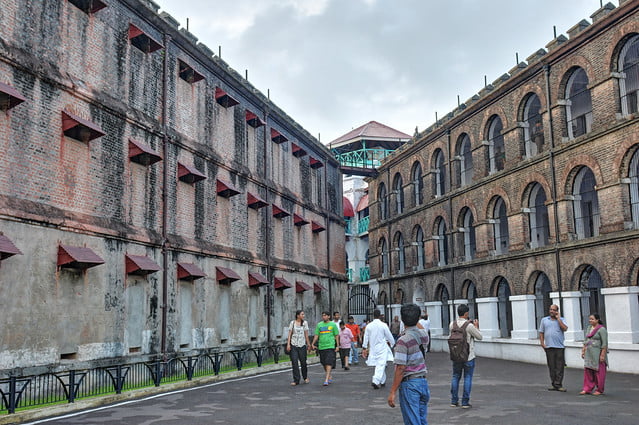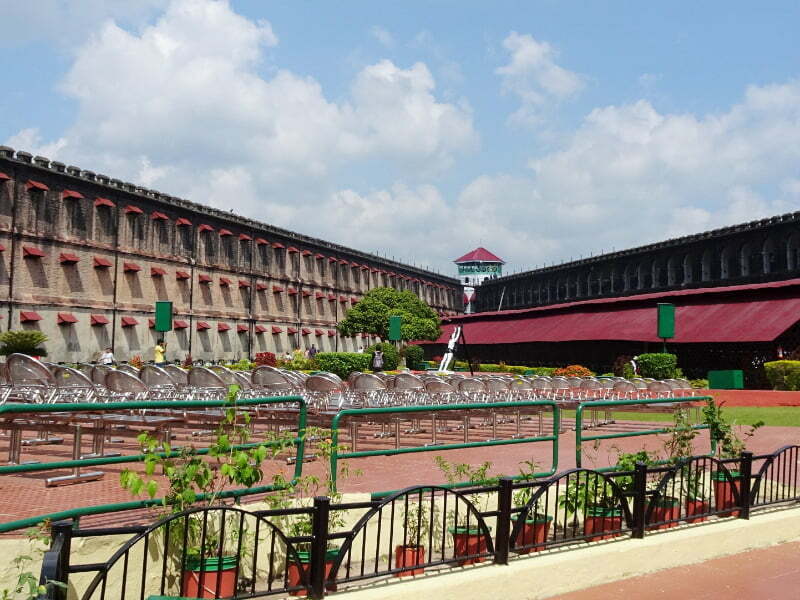Discuss the colonial history of the islands
The Andaman and Nicobar Islands have a rich colonial history, with the presence of various European powers shaping their past. Explore the captivating stories and remnants of colonial influence that still echo through the islands today.
1.British Rule:
The British Empire played a significant role in the islands’ history, establishing a penal settlement in 1858 known as the Cellular Jail in Port Blair. The Cellular Jail stands as a powerful symbol of the island’s tumultuous past, serving as a place of incarceration for political prisoners during India’s struggle for independence. Today, it stands as a national memorial, offering a glimpse into the harsh realities faced by those imprisoned here.

2.Japanese Occupation:
During World War II, the Andaman and Nicobar Islands came under Japanese occupation from 1942 to 1945. The Japanese constructed various installations and infrastructure across the islands, leaving behind remnants that serve as reminders of this period. Ross Island, once the administrative headquarters of the British, witnessed significant Japanese occupation and subsequent damage during the war.
3.Anthropological Significance:
The islands are also home to indigenous tribes, some of whom have had limited contact with the outside world. These tribes, such as the Jarawa, Onge, Sentinelese, and Great Andamanese, hold immense anthropological significance. Respect for their cultural heritage and the preservation of their unique ways of life are of paramount importance.
4.Maritime Exploration:
The Andaman and Nicobar Islands were frequented by various European explorers and traders, including the Portuguese, Dutch, French, and Danish, seeking to establish trading posts in the region. The islands’ strategic location on major trade routes made them a sought-after destination for maritime powers of the time.
5.Cultural Fusion:
The colonial history has left an indelible impact on the islands’ culture, resulting in a fusion of various influences. From the architectural styles seen in old buildings to the culinary delights influenced by different cultures, the islands bear the marks of this cultural amalgamation.
Exploring the colonial history of the Andaman and Nicobar Islands offers a fascinating journey through time. Uncover the stories of resilience, struggle, and the vibrant blend of cultures that have shaped the islands into the captivating destination they are today.

Mention the Cellular Jail and its significance
The Cellular Jail, located in Port Blair, is a poignant reminder of the Andaman and Nicobar Islands’ colonial history. It holds immense historical and cultural significance, serving as a symbol of India’s struggle for independence and the resilience of its freedom fighters.
1.Historical Significance:
Constructed by the British in 1906, the Cellular Jail was originally designed to house political prisoners who were actively involved in the fight against British colonial rule. The jail was specifically built to isolate and suppress revolutionary activities, earning it the reputation of being one of the most dreaded prisons in India.
2.Architecture and Design:
The Cellular Jail’s design is unique and distinctive, with seven wings radiating from a central watchtower. Each wing consists of multiple individual cells, hence the name “cellular.” The design ensured maximum isolation and minimal communication among the prisoners, intensifying their hardships and isolation.
3.Life Inside the Jail:
The conditions inside the Cellular Jail were harsh and brutal. Prisoners were subjected to hard labor, physical torture, and solitary confinement. They endured immense suffering and deprivation, yet their spirit remained unbroken, and they continued to fight for the cause of freedom.
4.Light and Sound Show:
Today, the Cellular Jail has been transformed into a national memorial, paying tribute to the freedom fighters who were incarcerated here. The jail complex features a captivating light and sound show that narrates the history and sacrifices of those who endured the hardships within its walls. The show is a poignant and emotional experience, bringing the stories of the past to life.
5.Symbol of Freedom Struggle:
The Cellular Jail stands as a powerful symbol of India’s struggle for independence and the sacrifices made by countless freedom fighters. It serves as a reminder of the price paid for freedom and the indomitable spirit of those who fought against colonial oppression.
Visiting the Cellular Jail is a humbling experience that allows visitors to connect with the history and the sacrifices of the freedom fighters. It serves as a solemn reminder of the hardships endured during the fight for independence and the need to cherish and uphold the values of freedom and democracy.
Describe the Japanese occupation during World War II
During World War II, the Andaman and Nicobar Islands came under Japanese occupation from 1942 to 1945. This period marked a significant chapter in the islands’ history, leaving behind traces of the Japanese influence that can still be witnessed today.
1.Strategic Importance:
The Japanese recognized the strategic importance of the Andaman and Nicobar Islands due to their proximity to major shipping routes in the Bay of Bengal. They sought to establish a strong foothold in the region to ensure control over crucial sea lanes and to counter British presence in the Indian Ocean.
2.Infrastructure Development:
The Japanese occupation brought about significant infrastructure development across the islands. They constructed airfields, naval bases, and defense installations, transforming the islands into a formidable stronghold. The remnants of these installations can still be seen, offering glimpses into the engineering feats achieved during that time.
3.Impact on Local Population:
The Japanese occupation had a profound impact on the local population. Many islanders experienced significant changes in their daily lives, as they were subjected to new rules and regulations enforced by the occupying forces. The occupation also resulted in economic changes, with locals being employed in various capacities to support the Japanese war effort.
4.Liberation and Aftermath:
The Japanese occupation ended in 1945 when the islands were liberated by the Allied forces. The aftermath of the occupation brought challenges of reconstruction and recovery, as the islands had endured the ravages of war. The liberation marked a turning point in the islands’ history, leading to subsequent developments and transformations.
5.Remnants of Japanese Influence:
Today, visitors to the Andaman and Nicobar Islands can explore remnants of the Japanese occupation. Places like Ross Island bear witness to the occupation and display remnants of Japanese structures and infrastructure. These remnants serve as tangible reminders of the islands’ wartime past and the struggles faced during that period.
The Japanese occupation during World War II left an indelible mark on the Andaman and Nicobar Islands. It shaped the islands’ infrastructure, influenced the lives of the local population, and contributed to their historical narrative. Exploring this aspect of the islands’ history offers a deeper understanding of the impact of war and the resilience of the people.
Highlight any historical landmarks or monuments on the islands
The Andaman and Nicobar Islands are home to several historical landmarks and monuments that bear testament to the rich and diverse history of the region. These sites offer glimpses into the past and provide a deeper understanding of the cultural, architectural, and historical heritage of the islands.
1.Ross Island:
Ross Island holds immense historical significance as the former administrative headquarters of the British during their colonial rule. Today, visitors can explore the remnants of British-era buildings, including the Chief Commissioner’s House, church, bakery, and barracks. The island stands as a captivating blend of lush greenery and fascinating ruins, transporting visitors back in time.

2.Cellular Jail:
The Cellular Jail, also known as “Kala Pani,” is a powerful symbol of India’s struggle for independence. Built by the British in the late 19th century, this infamous prison held many freedom fighters who fought against colonial rule. The jail’s architecture and design, with its seven wings radiating from a central tower, stand as a testament to the oppressive regime. Today, it serves as a national memorial, preserving the memory of those who sacrificed for the nation’s freedom.

3.Anthropological Museum:
The Anthropological Museum in Port Blair offers insights into the indigenous tribes of the Andaman and Nicobar Islands. It showcases a rich collection of artifacts, photographs, and displays that highlight the unique cultures, traditions, and lifestyle of the tribes, including the Jarawa, Onge, Sentinelese, and Great Andamanese. The museum plays a crucial role in raising awareness about the indigenous heritage of the islands.
4.Japanese Bunkers:
The islands also feature Japanese bunkers, remnants of their occupation during World War II. These bunkers are scattered across different locations, including Ross Island, Port Blair, and other strategic areas. They serve as silent witnesses to the wartime activities and stand as reminders of the islands’ wartime history.
5.Marina Park and Aquarium:
Marina Park in Port Blair is not only a recreational spot but also houses an aquarium that showcases the diverse marine life found in the Andaman and Nicobar Islands. Visitors can explore the fascinating underwater world and gain a deeper appreciation for the region’s rich biodiversity.
Exploring these historical landmarks and monuments provides an enriching experience, allowing visitors to connect with the past and appreciate the cultural heritage of the Andaman and Nicobar Islands. These sites serve as windows into the region’s history, offering a glimpse into the events, people, and influences that have shaped the islands over time.

